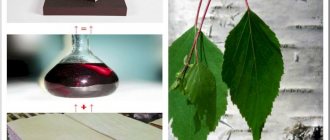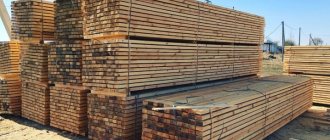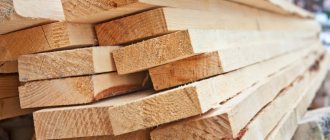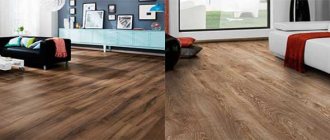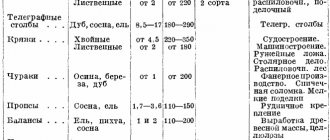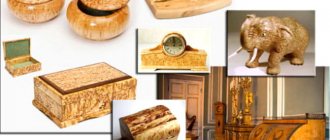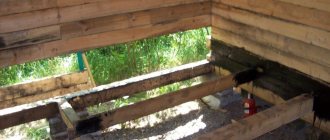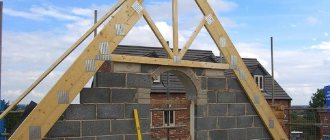What is an unedged board and how does it differ from an edged one?
Unedged boards are made by sawing a whole log lengthwise. Unlike cut ends, their ends are not processed and retain the bark coating.
Coniferous and deciduous trees are used to make the material. Due to wane, the boards are lower in class, but they are much easier to produce.
No complex or expensive procedures are required, so the final lumber has a lower cost.
Bar dimensions
- The dimensions of timber and bars are selected according to GOST 24454-80.
- The main ones that characterize consumer properties are the length and thickness of the edged timber.
- The standard length is 6 m, thickness is in the range of 100 - 250 mm with a width from 50 to 250 mm. The dimensional increment is 25 mm.
- Upon request, timber can be cut from 2 to 9 m in length.
- Permissible deviations in thickness and width: ±2 mm for sizes up to 100 mm and ±3 mm for sizes greater than 100 mm.
- Length deviation: from -20 to + 50 mm.
- The most common sizes of construction timber: 250x250, 200x200, 150x150, 100x100 and 80x80 mm.
- The bars have a thickness and width from 40 to 75 mm.
Types of unedged boards
There are two types of unedged boards:
- Fence. In appearance they are not particularly attractive. This lumber does not receive high-quality, good processing. Often there are many defects on its surface, such as stains, knots, chips or cracks. The boards themselves do not have good strength; in many cases they turn out to be quite fragile. When drying, wood usually changes the position of its cross section, which makes it quite difficult to use in construction. Poor quality, unreliability, fragility - all this does not allow fence boards to become a suitable material for building anything. So they are used for lathing or constructing secondary fences (where the name comes from);
- Carpentry. They are much better in quality than fence ones. These boards are made from high quality trees. Their trunks are usually quite large. Such trees can be Siberian larches or Angara pines. The minimum width of lumber is fifteen centimeters. The boards themselves either have no flaws at all or have several minor external defects. But the material will also cost more than fence material.
Cost per cube
I would like to say right away that the difference is quite significant. Of course, a lot depends on what material it is made from. If these are coniferous varieties, then the cost is somewhat cheaper, if these are deciduous “durable” varieties (for example, oak) - more expensive. Also, the price greatly depends on the type of wood, there are 5 of them in total (according to GOST), you can talk about them.
Unedged option, cost per cube starts from 2000 to 5000 rubles.
Edged version, cost per cube starts from 3,500 to 8,000 rubles.
What raw materials is it made from?
If we talk about the wood that is taken to make lumber, then most often these are coniferous trees. Pine is considered the most popular: it is often used in construction, because it is easy to work with, and it grows in large quantities in many places.
This rock also practically does not rot, and thanks to the special structure of its cells, it is able to pass air through it.
- Spruce trees are not so well-developed in texture, and they have a large number of knots throughout the trunk. They can split after drying and become severely rotten. Because of this, it is practically not used in the creation of wooden buildings, furniture and other similar products.
- Larch is considered a good raw material for creating boards, due to its strength, density and increased protection from rot and pests. It is durable, reliable and has many other advantages, but it is too heavy wood.
- Cedar wood is soft, easy to work with and has a very attractive texture, which is why many people like it. It is almost not subject to rot, so you can use it even on the street.
Among deciduous trees, oak is especially valued. It has good strength and mechanical hardness, does not rot and is easily pickled. Oak raw materials are easy to work with, and its texture is very good in appearance.
Ash is very similar to oak, but unlike it, it has a lighter texture. This breed is also susceptible to rotting in high humidity. To prevent rot from appearing, ash is treated with special antiseptic preparations. If you steam this wood, it will begin to bend well as needed.
Beech is also similar to oak, but not in texture, but in strength. It is easy to saw and bend. You can easily drill a hole in a beech board or saw off any part. The disadvantage of beech is its strong tendency to rot. So it is not recommended to place products made from its wood in places with high humidity.
Timber classification
The main characteristics of edged timber must comply with the requirements of GOST 8486-86.
Depending on the presence of wood defects, timber is divided into four grades:
- The first grade has minimal flaws in the form of shallow cracks up to 150 mm long and 2-3 small knots per linear meter. It is used for the manufacture of walls, frames, roofs, and as joists for floors.
- Second grade: cracks up to 200 mm, 3-4 small knots, small wormholes are allowed, fungal lesions up to 10% of the surface area.
- It is used for the manufacture of windows, door frames, wooden machine parts, in carriage and shipbuilding, and in furniture production.
- Third grade: the same defects, fungal infections of wood up to 20%. Area of application: outbuildings, temporary sheds, fences, lathing.
- In the fourth grade, defects are not standardized; the main condition is the physical integrity of the material. Used for the manufacture of minor parts during construction.
Grades 1,2,3 are produced with a moisture content of no more than 22%, for the fourth it is not standardized.
Edged bars, like boards, are divided into 5 grades. The requirements for them are in accordance with GOST 8486-86.
How to choose an unedged board
Unedged boards may not seem that important, but you should approach the choice extremely carefully. The first thing to consider is the smoothness of the surface. There should be no chips on it.
- Otherwise, processing and using the boards will be extremely problematic. Also inspect the lumber for cracks - if there are any, then the boards were stored incorrectly.
- When they lie at an inappropriate temperature for a long time, they begin to crack. On high-quality material you will not find even minimal cracks.
- Knots cause a lot of harm, because a knotted board is not only unattractive in appearance, but also lacks the required strength. Such boards are not particularly reliable, but their use is acceptable. This only happens if the size is not too large.
Another nuance that is important to pay attention to is the warping of the board. Ideally it shouldn't exist. Lumber begins to warp due to overdrying or excessive moisture.
High-quality unedged boards must be smooth and even. It is impossible for them to be winged, since such a defect will complicate further processing, and it will no longer be possible to eliminate the problem.
If you choose lumber to decorate the front side of the building (even the secondary side), then be sure to take into account the texture and shade of the wood. And, of course, consider the reputation of the manufacturer.
If you pay attention to the choice of unedged boards, there will be no problems or difficulties in your future work, so check everything carefully and take into account every nuance.
Our production
| 25×6000 | 3800 rub. |
| 40×6000 | 3800 rub. |
| 50×6000 | 3800 rub. |
| 650 rub. |
| 9000 rub. | |
| 145×190 | 9000 rub. |
| 195×190 | 11000 rub. |
| Edged board (grade 1) | timber |
All photos from the article
Today, one of the most popular lumber on the market is unedged board, which is due to its low cost, strength, and also the possibility of use in a wide variety of areas of construction. Next, we will get acquainted with this material in detail, and also consider how edged and unedged boards differ, and for what purposes they are used.
